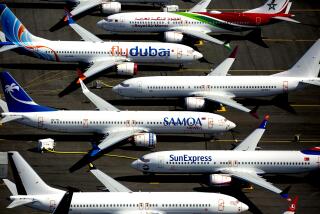PERSPECTIVE ON U.S. AIRLINES : A Competitive Jolt From Abroad? : Deregulation killed or damaged many carriers. Foreign investment could provide a more level playing field.
- Share via
Here comes another shaky, debt-laden American airline seeking refuge with a rich European company. Northwest and KLM Royal Dutch Airlines have asked U.S. government permission to form what would, in effect, be a unified global airline. KLM had already bought 49% of the stock in Northwest’s parent company.
Last month, British Airways announced plans to acquire a 44% equity stake in USAir for $750 million. Continental and the Scandinavian Airlines System have formed an alliance. Events are moving quickly. The cherished concept of proud and independent U.S. flag carriers is being challenged.
Given the financial state of the airline industry, these events, rather than being cause for concern, may be one of the few bright spots on the scarred landscape of post-deregulation aviation.
By preventing the demise of more U.S. airlines, foreign investment could help ease the unforeseen consequences of airline deregulation. The great hopes for deregulation depended on one major factor: competition. Yet the policy has had an opposite effect, contributing instead to the decline and fall of many American carriers.
Today, most U.S. carriers are laden with debt, vulnerable to cyclical downturns and saddled with aging aircraft fleets. The list of corporate casualties so far includes some of the great names in U.S. airline history--Eastern, Pan American, Midway, People Express and Braniff. Recent losses of more than $6 billion amount to more than the industry earned since the first scheduled commercial flight in 1925. More to the point, the “savings to the public” claimed so far have been very expensive for the airlines, their employees, investors, banks and perhaps even American taxpayers. After all, the losses from recent bankruptcies, including unfunded pension liabilities guaranteed by the federal government, will be paid for by somebody, someday.
There were flaws in the key assumptions underlying the notion of creating a competitive, efficient, safe and cheap aviation system through deregulation. The deregulators apparently thought that travel agencies were obsolete, that centralization was not natural and that barriers to entry into the industry were low. Granted, the deregulators serving President Carter could not have foreseen the collapse of antitrust enforcement under the Reagan Administration (an incredible decision for an industry with a well-documented history of price-fixing), the wrongheadedness of airline management and the destructive consequences of certain changes in bankruptcy law. The key lapse was the failure to grasp that a wide-open market would lead to centralization.
Another troubling development is that the hub-and-spoke system of airline operations, which is becoming the national norm, has anti-competitive implications. Almost half of the passengers in the United States fly on routes served by only one or two airlines. Because the airlines participate in financing most airport improvement and expansion projects, the carriers that reign supreme at many hubs are able to, in effect, veto projects that would enhance airport capacity and promote wider competition.
But pumping fresh foreign capital into their weaker sisters might partially offset these advantages of dominant carriers and encourage airport operators to add the capacity needed to allow competition to flourish.
Changes are needed to make it more attractive for foreign investment to flow to the U.S. market. For all those millions, for example, British Airways only buys 21% of the voting rights in USAir. Under federal law, foreign holdings cannot exceed 25% of voting stock in a domestic airline. (Four percent of USAir apparently already is in foreign hands.) Until recently, Washington was even tougher about keeping U.S. flag carriers from foreign control.
We need a new “competition policy,” a strategy designed to save and enhance what competition remains. Such a strategy would include six elements:
-- Stronger antitrust enforcement.
-- Aggressive programs of infrastructure investment and regulatory changes to increase airport capacity and encourage competition at airports.
-- Limits on market share in cities now or close to being dominated by one airline.
-- Continued reform of centralized captive reservation systems and anti-competitive frequent-flier programs.
-- Further relaxation of the restrictions on foreign firms investing in domestic carriers.
-- An expansion of the foreign flag competition permitted on domestic routes (assuming we can obtain reciprocity for our carriers abroad).
The last two suggestions may be bitter medicine for the domestic airline business, but think of them as part of the “due bill” for the wheel-and-deal policies of the 1980s. Remarkably, the survivors of an industry that begged for a free marketplace have responded to the stress of deregulation by pleading for special benefits from Washington. The most important, and the most costly for taxpayers, involve tax breaks for the industry.
The sad truth is that we cannot go back to the good old days. And we certainly should not give up on the concept of increased competition. It’s a time for realism, and for a new look at federal policies that should be designed to produce competition.
More to Read
Inside the business of entertainment
The Wide Shot brings you news, analysis and insights on everything from streaming wars to production — and what it all means for the future.
You may occasionally receive promotional content from the Los Angeles Times.










